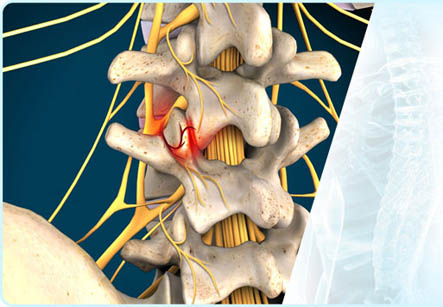Facet Thermal Ablation
Introduction
Facet thermal ablation is a minimally invasive surgical procedure which is similar to root canal treatment in dentistry. This procedure involves short recovery time and little scar tissue. A laser is used to clean the facet joint and deaden the nerves that cause pain.
The Facet joints are the joint structures which connect the adjacent vertebrae to one another. The facet joint is like any other joint in the body. These joints have cartilage lining which allows the bone to glide smoothly over one another and a capsule surrounding the joint. The function of the facet joint is to provide stability, support, and mobility to the vertebrae (spine). Facet Disease occurs when there is degeneration of this facet joint.
Facet Disease is also known as spondylolithesis. In this disease, one vertebra slips forward in relation to an adjacent vertebra, usually in the lumbar spine. When the facet joints degenerate, they may inflame, or pinch the spinal cord. Damage to facet joints may cause severe pain as the joints themselves are highly innervated, meaning that they contain many sensitive nerves.
We have all the information you need about public and private clinics and hospitals that provide spinal surgery in Iran, Islamic Republic Of with the best quality and lowest possible prices

The physician can diagnose above mentioned back and spinal conditions by proper history, physical and neurological examination.
Once the facet thermal ablation procedure is performed, the patient does not usually feel pain in or around a damaged joint facet. This procedure doesn’t reverse the damage caused by degeneration, but it is an effective treatment for many severe back pain symptoms. In conjunction with light exercise and lifestyle modifications, it can help to combat back pain and spinal conditions.
Principal of Facet Thermal Ablation:
Facet thermal ablation procedure uses fiber optic laser surgery to fix the facet joints in the spine. No general anesthesia is required and it is a safe alternative to open back surgery. The process is as follows:
• Local anesthesia and intravenous sedation is given to the patient.
• The surgeon makes a small incision in the affected area of back and a 5 mm tube is inserted in the back. The tube contains an irrigation channel, fiber optic assembly and laser device. This allows the doctor to perform the procedure without damaging surrounding muscles and soft tissues.
• The doctor clears the vertebrae of bone spurs and inflamed spinal disc fragments using the irrigation and laser under the guidance of fiber optics assembly.
• After this, the surgeon destroys the nerves in the inflamed or damaged spinal disc using the laser. This should reduce pain in the affected disc.
• The surgeon removes the tube and bandages are applied to the incisions. Further ablations are performed if necessary on other joints.
• The surgery is accomplished after about 1-2 hours of monitoring. After the surgery, the patient can start to take a short walk, but intense exertion should be avoided for the rest of the day. The patient needs to visit the doctor on the next day for a post-operative check-up.
• The entire surgery takes about 40 minutes without including the post-op monitoring. Scarring is minimal, and the patient is usually able to quickly return to the normal activities.
Conditions Treated by Facet Thermal Ablation:
Facet thermal ablation may be used to treat a number of back and spinal conditions such as:
1. Facet joint syndrome
2. Hypertrophy of facet
3. Osteoarthritis
4. Tearing of annulus
5. Degeneration of facet joints
Any of these conditions may result in several symptoms. The most common symptoms are:
1. Chronic or intermittent pain
2. Numbness and tingling
3. Tenderness and loss of spinal flexibility.
Other symptoms include:
1. Muscle weakness
2. Difficulty in sitting or standing
3. Loss of bladder, bowel or sexual function or control
4. Increased sensitivity to cold and humid weather
5. Fever
6. Headache
7. Insomnia or lack of sleep
8. Temporary paralysis
Getting Facet Thermal Ablation
The physician can diagnose above mentioned back and spinal conditions by proper history, physical and neurological examination. The doctor may recommend getting an X-ray or MRI scan done before suggesting this procedure.
Facet thermal ablation is generally used to treat the most severe forms of back injury. However, due to its advantages such as minimally invasive nature, short recovery time, and high success rate, it may also be used to treat other forms of back conditions. The doctor can decide whether the facet thermal ablation is suitable for a specific condition.